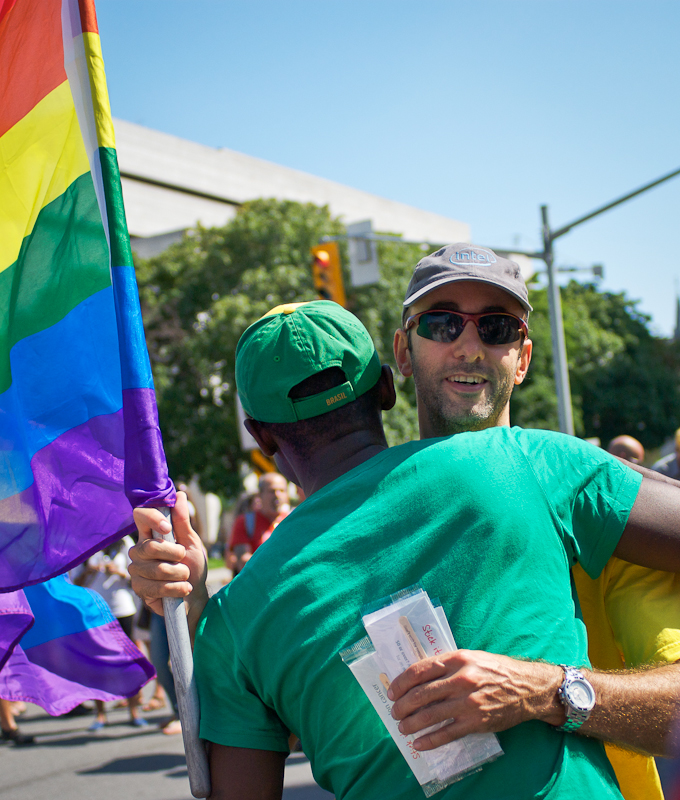Three decades of Capital Pride history were on display when grand marshals from its first 30 years marched in Ottawa’s annual Pride parade on August 23.
Under new management following Capital Pride’s bankruptcy last year, spokesperson Tammy Dopson said it will be placing an emphasis on maintaining the momentum of the movement.
“We have been given a certain amount of gains, and we do get complacent once we find our comfort zone,” Dopson said. “So the movement has to change.”
A lot has changed throughout Capital Pride’s 30 years. It has evolved from a small event to one of the city’s most popular ones. So too have discussions surrounding inclusion and the LGBTQ community.
Reflecting on the history of Pride and returning this year, Joanne Law said it is “like a soldier going back to the war.”
Law is a trans woman and a founding member of Gender Mosaic, a support group for Ottawa’s transgender community. Law has been involved with Capital Pride for more than two decades.
She said Capital Pride in its initial years was not always supportive of trans people.
“This was 20 years ago—being trans wasn’t even a word in anybody’s vocabulary,” Law said. “We’re 20 years behind the gay and lesbian community.”
Since then, Law has advocated for the inclusion of transgender people and volunteered for Capital Pride. In 2006, Law became the first trans woman to chair a Pride celebration in Canada.
Thirty-five years earlier, Ottawa was the site of Canada’s first public gay rights protest, when about 100 people marched on Parliament Hill. It was only two years after Canada had decriminalized homosexuality.
Then, the issues protested were employment discrimination, child custody, and hate violence.
Even after the decriminalization of homosexuality, Ottawa was not the most welcoming place for queer people, said Brian Hobbs, a retired civil servant who moved to Ottawa in 1977.
“It probably wouldn’t have been so great for my career had I been very involved in an open way in the gay community,” he said.
Only a decade before, the Canadian government had developed and used a device intended to filter out homosexuals from government jobs. Developed by a Carleton professor, these devices, called “fruit machines,” led to firings and the RCMP amassing files on over 9,000 people.
“I was always afraid of being found out,” Hobbs said.
Hobbs said he believes the legacy of “fruit machine” experiments may have contributed to negative attitudes towards homosexuals in public sector-heavy Ottawa in the 1970s.
While achieving success following the decriminalization of homosexuality, the LGBTQ movement faced a hurdle in the AIDS crisis of the 1980s. Mobilization largely became about surviving.
The first manifestation of what would become Capital Pride was a picnic organized by the Gays of Ottawa organization in 1986, at the height of the epidemic.
“That’s also when lesbians became involved in the movement because our gay male brethren were not able to take care of themselves,” Dopson said.
She added the AIDS crisis had introduced gays and lesbians to the mainstream media, which educated heterosexual people about the queer community.
Since then, Capital Pride has grown increasingly in popularity. In 1991, about 500 people marched in its parade. That same year, the Carleton University Students’ Association voted unanimously to dedicate campus space to its LGBTQ community.
In 2002, more than 55,000 people attended the pride parade, according to Charlatan records. It has only grown since.
Since its mainstream success, intersectionality between LGBTQ and other identities has increasingly been discussed at Capital Pride, including Indigenous identities.
The term two-spirit has recently been adopted by some Indigenous members of queer communities. Two-spirited people regard themselves as having both male and female spirits within them.
Although Capital Pride celebrates 30 years, gender diversity and sexuality was respected by Indigenous people in the region long before Europeans arrived in the Ottawa Valley, said Sharp Dopler, a two-spirited individual who works in the Aboriginal community.
“Many First Nations across Turtle Island had an understanding of more than two genders,” Dopler said. “We were healers, and visionaries, and medicine people.”
Dopler identifies as agokwe-nini, an Ojibway term that refers to “someone who is born in a female body but is more.” They said that two-spirit people were often responsible for welcoming newcomers to Indigenous communities.
When European colonizers encountered two-spirited Aboriginal people, their response was violent, Dopler said.
“They were incredibly brutal once they did the math and figured out what we were,” Dopler said. “And their response was to feed us to the dogs.”
Today, homophobia is persistent in many Indigenous communities, Dopler said. As a result, many two-spirit people do not feel accepted by First Nations but also the queer community, Dopler said.
R.J. Jones, a two-spirited Cree individual who spoke at Capital Pride’s human rights vigil August 20 and uses the pronoun ‘they,’ said they believed homophobic attitudes had been passed down by Aboriginal people who had developed it while attending residential schools.
According to Law, Capital Pride has always been about standing in solidarity with LGBTQ communities’ diversity.
“Pride was never a commercial endeavour. It’s always been grassroots,” she said.
Under its new organizing committee, Tammy Dopson said Capital Pride will be incorporating a greater educational component, in keeping with its original intentions.
“Pride has to continue as a protest,” she said.






